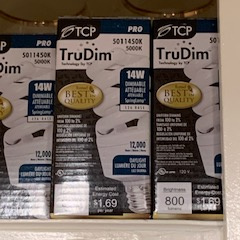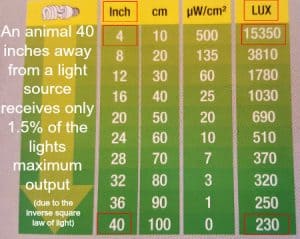
How Would We Revamp Lighting for a Harligold & Greenwing Macaw?
Last Updated on by Mitch Rezman
Jayda (above)
Dear Mitch and Catherine,
We are empty nesters owned by our only pets, a harligold and a greenwing macaw. After reading some of your articles on correcting parrot lighting issues, we are aware that their lighting setup needs some revamping.
Our old 1967 house had living room track lighting. Situated on a beam between their cages, we updated it with four smaller fixtures and TruDim daylight bulbs.
During the day, they get sunlight when we raise the shades on the French doors by Jayda’s cage, as well as the large windows in the living room and adjoining breakfast room.
Both harligold Jayda, age 13, and greenwing Valentin, age 9, have started exhibiting hormonal behavior intermittently this year.
It’s quite ironic as they tolerate each other but don’t seem interested in each other as mates!
The new behaviors are feather chewing on the shoulders and legs.

Valentin is more aggressive and vocal while playing with his toys.
We intend to bring them out of their cages daily for a few hours unless they object.
For about half the day now, Valentin is reluctant to step out of his cage. Jayda crouches down and is uncooperative about exiting the cage about twice a week. This cage territoriality is new behavior for both of them
I tried covering both cages with dark sheets at night. She is naturally high-strung and was disturbed by this. He started ripping his sheet to shreds!
Their basic diet is Lafeber’s or Roudybush pellets, Avi-Cakes, Nutriberries, and a little daily fruit and cooked vegetables in treat cups. They drink Brita filtered water from Lixit bottles. Recent trips to the avian vet have revealed all normal test results, with a sales pitch for expensive Lupron shots that we declined.
We would like to install 12-hour timers with the specifications, fixtures, and bulbs that you recommend. I am attaching some photos of the birds and their cage arrangements.
Thank you for your advice and ongoing support for all of us parrot lovers I will be happy to answer any questions you may have about their situation.
Lorna Hill & Ron
Thank you Lorna and Ron for being loyal readers
The story and images are most telling and you are anything but empty nesters
We now house 11 birds in 4 cages, the ringneck and Quaker have “day cages” downstairs too.
The budgie aviary recently arrived on the upper level to allow for more retail space below.
I’ll be talking about the impact of lighting on the budgie aviary in a moment, but first I’d like you to view this video.
We are birdcage lighting evangelists ~ Video.
Here’s context providing the overview, that this is not something we read and then developed a “surefire strategy” based on our “internet research”
At the time we were selling a product named “Releaves” Harrison’s was offering for “prolific egg-laying birds”.
A Windy City Parrot customer called wanting to know what the instructions meant that read something like this.
“It’s best to use Releaves, in conjunction with 72 hours of “light therapy”
I Want My Freakin Bird Back but She’s Held Hostage by Her Eggs
Dr. Gregory Harrison is the founder of Harrison’s bird food pellet line.
I had never met or spoken with the man but I’m sure he knew who I was because we had been retailers of his products going back to 2005.
The brand was and still is on the shortlist for avian veterinarian recommendations.
That said I called the good doctor confused about that customer’s inquiry as I, bearing the male chromosome, never read the directions, for Releaves.
Whoever answered the phone didn’t hesitate to transfer my call upon sharing who I was, a pleasant surprise.
In the next moment I was speaking, no, listening to one of the greatest minds of avian nutrition spanning 2 centuries.
I immediately learned it was “light therapy” not the Releaves which was responsible for the reduction in egg laying.
In the simplest of terms birds and humans both have circadian rhythms.
When human circadian rhythms are out of sync usually in the winter when we get “ the Blues”, we get expensive lights to make us feel better.

72 hours of light therapy where the birds are locked in their cages and exposed to light for 3 days and nights, which does one thing, it resets a bird’s circadian rhythm.
And here we are 6 years after that fateful conversation.
Since we learned when we brought them up here from areas around the equator their instilled hundred billion years of instinctual expectations cause much confusion in their minds like “Why is it getting dark at 5 pm in North America?”
The light cycle of a bird affects them far more than any other species on the planet.
Light cycles signal birds to molt, mate, migrate, and so forth.
With this bad streaming information, also comes from the lack of lunar cycle visuals (housed inside).
The 72 hours all light therapy might have to be done twice or a second session extended to 168 hours, a whole week for greater efficacy.
We know the folks at https://hari.ca/ and https://ovc.uoguelph.ca/ have done much more research.
I’ve heard more than one vet say “We don’t know what triggers hormonal activities, dark or light?”
What we have learned is that it starts, which is why when you see your birds crawling under furniture or into cabinets are seeking a place to breed, someplace dark and dry.
Parrots do not build nests, by the way, only Quaker parrots.
Most breeding activity occurs in dark tree hollows, which can fill with water when raining, but that’s another story.
Clearly, our knowledge base of lighting has expanded ~ you can find many posts here.
Circling back to lighting for Jaydas and Valintins cage
Here are the bulbs you’ve selected

and Jaydas cage

something called the inverse square law of light (sound, energy) is preventing your birds from getting enough lighting ~ they are too far away
The graphic on this box says it all

Lighting efficacy is determined by light source distance and the timing of the light source.
Without access to all the angles in the room, it’s hard to make a complete assessment.
Because of your expansive use of track lighting, the first place I would look is to bring the lights closer to the birds with extenders.

In-wall timers are available

I know this is a lot to think about let alone execute, we’re here to help.
I mentioned, the budgie aviary earlier.
It came upstairs with the same 3 lights (on a timer in the video above).
The prior space was between two large double-hung windows on either side bathing the little hoodlums in lots of natural sunlight.
The aviary was in a well-lit living room at our prior residence.
For 6 ½ years in spite of a mixed-sex aviary, we never saw an egg.
Within a month of moving the full budgie aviary upstairs where there are literally 18 to 20 lighting fixtures turned on during the day, we had 2 eggs within a month.
As for the cage cover shredding, some areas must be exposed so the animal is not subjected to total darkness.
I have built. in the past, a rectangular frame out of PVC slightly larger than the cage. The cover (sheet) would be draped away from the frame impeding the bird’s ability to access the fabric. A pulley system was employed to entend the contraption from the ceiling
Written by Mitch Rezman
Approved by Catherine Tobsing
You might also like ~ Is Budgie Breeding Predictable or With Unexpected Consequences?
Author Profile
Latest entries
 The Traveling BirdJune 26, 2025Can You Name 5 Parrot Species That Are Living Wild in the USA?
The Traveling BirdJune 26, 2025Can You Name 5 Parrot Species That Are Living Wild in the USA? Bird BehaviorJune 26, 2025How is it Parrots Are Problem Solvers Social Animals and Even Use Tools?
Bird BehaviorJune 26, 2025How is it Parrots Are Problem Solvers Social Animals and Even Use Tools? Bird & Parrot AnatomyJune 25, 2025How a Tiny Chemical Modification Makes Parrots Nature’s Living Paintings
Bird & Parrot AnatomyJune 25, 2025How a Tiny Chemical Modification Makes Parrots Nature’s Living Paintings PigeonsJune 20, 2025How Do Parrots Thrive in Cities Outside Their Native Habitats?
PigeonsJune 20, 2025How Do Parrots Thrive in Cities Outside Their Native Habitats?


